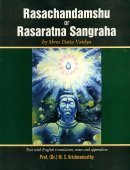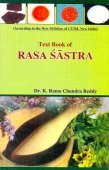Srotonjana, Srota-anjana, Srotoñjana: 7 definitions
Introduction:
Srotonjana means something in Hinduism, Sanskrit. If you want to know the exact meaning, history, etymology or English translation of this term then check out the descriptions on this page. Add your comment or reference to a book if you want to contribute to this summary article.
In Hinduism
Ayurveda (science of life)
Rasashastra (Alchemy and Herbo-Mineral preparations)
Source: Wisdom Library: Rasa-śāstraSrotoñjana (स्रोतोञ्जन):—One of the five variations of Añjana (‘collyrium, galena’), which is part of the uparasa group of eight minerals, according to the Rasaprakāśasudhākara: a 13th century Sanskrit book on Indian alchemy, or, Rasaśāstra. It is greasy in appearance. It is also known as Srotāñjana (स्रोताञ्जन).
Source: Indian Journal of History of Science: Rasaprakāśa-sudhākara, chapter 6Srotoñjana is a variety of Añjana (“Collyrium”).—It is snigdha (greasy) in appearance, madhura and kaṣāya in Rasa, lekhana in Karma, destroys viṣa-prabhāva, vami (vomiting), pitta and rakta-rogas. It is good for eyes and cures hidhmarūjā (distress due to hiccough) always.

Āyurveda (आयुर्वेद, ayurveda) is a branch of Indian science dealing with medicine, herbalism, taxology, anatomy, surgery, alchemy and related topics. Traditional practice of Āyurveda in ancient India dates back to at least the first millenium BC. Literature is commonly written in Sanskrit using various poetic metres.
General definition (in Hinduism)
Source: Alois Payer - Amarakośa: Vaiśyavarga 100-106bSrotoñjana (स्रोतोञ्जन) is described as of white colour, and is said to be produced in the bed of the Jamuna and other rivers. It is called saffed surmā in the vernacular, and the article supplied under this name by Hindustani medicine vendors is calcareous or Iceland spar. It is used as a collyrium for the eyes, but is considered inferior to the black surmā or galena.
Languages of India and abroad
Sanskrit dictionary
Source: Cologne Digital Sanskrit Dictionaries: Shabda-Sagara Sanskrit-English DictionarySrotoñjana (स्रोतोञ्जन).—n.
(-naṃ) Antimony. E. srotas a stream, and añjana collyrium.
Source: Cologne Digital Sanskrit Dictionaries: Monier-Williams Sanskrit-English DictionarySrotoñjana (स्रोतोञ्जन):—[=sroto-ñjana] [from sroto > sru] n. ‘stream-collyrium’, antimony ([especially] as a collyrium for the eyes, said to be produced in the river Yamunā), [cf. Lexicographers, esp. such as amarasiṃha, halāyudha, hemacandra, etc.]
Source: Cologne Digital Sanskrit Dictionaries: Yates Sanskrit-English DictionarySrotoñjana (स्रोतोञ्जन):—(naṃ) 1. n. Antimony.
[Sanskrit to German]
Sanskrit, also spelled संस्कृतम् (saṃskṛtam), is an ancient language of India commonly seen as the grandmother of the Indo-European language family (even English!). Closely allied with Prakrit and Pali, Sanskrit is more exhaustive in both grammar and terms and has the most extensive collection of literature in the world, greatly surpassing its sister-languages Greek and Latin.
See also (Relevant definitions)
Partial matches: Shrota, Sroto, Anjana, Ancana.
Query error!
Full-text: Anjana, Srotoja, Srotanjana.
Relevant text
Search found 10 books and stories containing Srotonjana, Srota-anjana, Srota-añjana, Sroto-njana, Sroto-ñjana, Srotoñjana; (plurals include: Srotonjanas, anjanas, añjanas, njanas, ñjanas, Srotoñjanas). You can also click to the full overview containing English textual excerpts. Below are direct links for the most relevant articles:
Rasa Jala Nidhi, vol 2: Minerals (uparasa) (by Bhudeb Mookerjee)
Part 3 - Solidification of mercury by means of srotonjana < [Chapter XIV - Uparasa (15): Anjana (stibnite, sulphide of lead)]
Part 2 - Purification of anjana < [Chapter XIV - Uparasa (15): Anjana (stibnite, sulphide of lead)]
Part 1 - Characteristics of Anjana (stibnite, lead sulphide) < [Chapter XIV - Uparasa (15): Anjana (stibnite, sulphide of lead)]
Vinaya (2): The Mahavagga (by T. W. Rhys Davids)
Mahavagga, Khandaka 6, Chapter 11 < [Khandaka 6 - On Medicaments]
Amarakoshodghatana of Kshirasvamin (study) (by A. Yamuna Devi)
Economics (3): Goods of trade < [Chapter 3 - Social Aspects]
Sushruta Samhita, Volume 6: Uttara-tantra (by Kaviraj Kunja Lal Bhishagratna)
Chapter XVII - Treatment of diseases of pupil and crystalline lens < [Canto I - Shalakya-tantra (ears, eyes, nose, mouth and throat)]
Chapter XV - Treatment of eye-diseases which require Excision < [Canto I - Shalakya-tantra (ears, eyes, nose, mouth and throat)]
Chapter LX - Symptoms and Treatment of demonology (Amanusha) < [Canto IV - Bhuta-vidya-tantra (psychology and psychiatry)]
World Journal of Pharmaceutical Research
Role of dincharya in prevantion of lifestyle disorders < [2021: Volume 10, April issue 4]
A review of xerophthalmia due to vitamin-a deficiency with ayurvedic management < [2019: Volume 8, January issue 1]
Journal of Ayurveda and Holistic Medicine
Role of ayurveda in management of lifestyle disorders of netra < [Volume 9, issue 3 (2021)]
A Significance of Bhringaraja as a thoughtful protagonist for Ayurvedic phramaceutical process < [Volume 11, issue 2 (2023)]
Utility of rasadravyas in panchakarma < [Volume 7, issue 2 (2019)]
Related products

